KITCHEN HEROES
Meet the Reids, South Africa’s AGA cardiologists
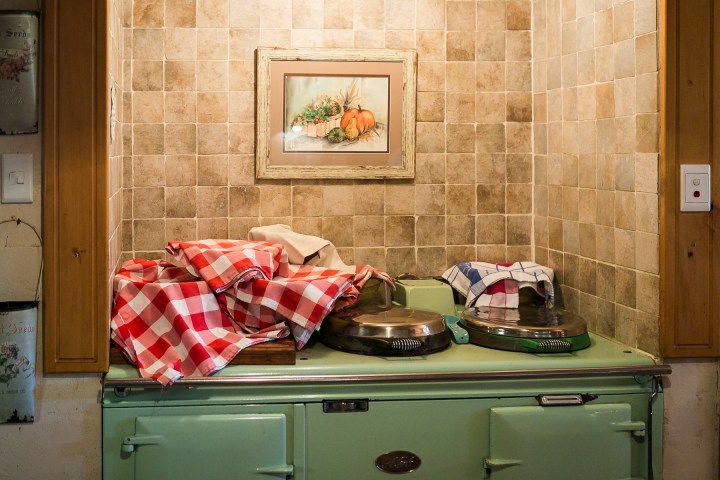
It’s the beating heart of many a farmhouse kitchen... and South Africa’s coal-stove cardiologists won’t skip a beat to keep them burning at full steam. Meet the Reids, a family of travelling craftsmen with a generational love for old coal and wood-burning stoves.
The writer supports the Gift of the Givers Foundation’s Drought Relief programme.
“Stay as cool as a cucumber… Calm as a Psalm.”
If you’ve met Arthur Reid, you’ve heard this phrase. Often spoken in reassurance to ease the hearts of AGA, Dover and Jewel owners dreading the demise of their kitchen cornerstones. But, as Arthur will tell you, “There is no end to a coal stove. Once you become used to a coal stove, you can never live without it again…
“For a moment there,” he tells us, “the arrival of Eskom looked like the end of these coal-burning stoves. Many people removed the stoves from their homes, eager to replace them with electric ovens.”
Oh, how times have changed in recent years…
“The stoves waited patiently on the farm outbuildings…” Oom Arthur says, smugly. “And one by one, I was called back to reinstall them. The people simply could not do without them. The stoves are always on, so they keep the family together. And it’s ready to work, 24 hours a day.”
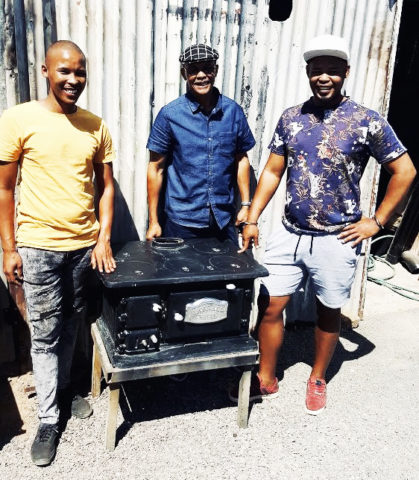
Oom Arthur (middle) and his two sons and business partners, Randall (left) and Ralton (right), seen here in front of their home workshop with a wood-burning Dover stove. (Photo: Chantelle Marais)
Arthur Reid has witnessed the rise, fall and resurrection of the old farmhouse stoves first-hand. For the past 44 years, he’s travelled more gravel roads and R70-somethings than every season of Boer-Soek-’n-Vrou’s crew, combined. He works with his two sons, Randall and Ralton, who have learnt the trade travelling with their father.
It all started in the early ’70s, Oom Arthur says, under the guidance of the late AGA-master Willie Serfontein, who taught him the ins and outs of the machine. Arthur continued serving the AGAs on his own after Willie’s passing in 1980.
“Later on, the boys wanted to drive with me. Randall was about nine years old when we started coming with, out of curiosity more than anything.”
“Origheid,” Randall calls it. “Being nosey! That’s where my love and interest for the AGAs started. I started going with my dad on the trips, then reading all of his books… I still read them today. They’re much older than me, but still very much alive with knowledge.”
Randall has a knack for understanding the coal stoves’ more scientific qualities. Though they seem simple, they’re a marvel of many cast-iron parts functioning together in perfect unison.
“The AGA is very different from other stoves,” Randall says. “It’s insulated with an old material known as Kieselguhr, made with a form of silica composed of the siliceous shells of microscopic aquatic plants,” he says. “These days, the new AGAs use vermiculite for insulation, which is much cheaper than Kieselguhr. The old ones still have their original Kieselguhr though.”
Arthur’s youngest, Ralton, is also a part of the coal-stove business. When Randall is tied up, Ralton accompanies Arthur as his right-hand-man, and vice-versa.
“There’s an opportunity to expand the business and I’d like to help my dad to do that,” Ralton says. He’s 30 years old. “We’re faced with a massive electricity crisis in South Africa. The coal and wood-burning stoves are becoming more popular because of it.
“There’s also very little job opportunities where we are, so we can help employment if we go bigger. We are heading into our busy season now – during winter – but in the summer months, things are slower… and we need to stay busy.”
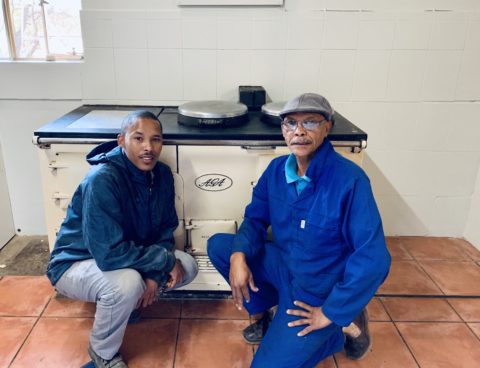
Ralton Reid (left) and his father, Arthur, ready to dissemble an AGA. (Photo: Karen Jordaan)
Randall and Ralton have big plans for the future, but Arthur, at age 65, still calls the shots on a day-to-day basis.
Together they service, repair and install the ancient machines, which in turns fuels the heart-fires of South Africans. The Reids are based in Graaff-Reinet, in perfect proximity to coal-stove heartland.
Behind the wheel of his 1989 cream Datsun bakkie, Arthur and his sons follow the stoves’ calls. From Eersterivier, through the Karoo and Cape to Empangeni and up, into Limpopo, the stoves are scattered all across the country, Arthur says.
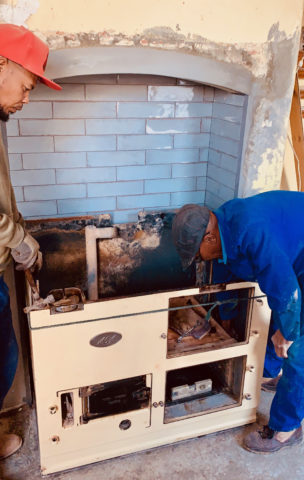
Arthur Reid and his son, Randall, assembling an AGA after relocating it. The AGA is insulated with a special matter, namely kieselguhr – aka diatomaceous earth. (Photo: Louzel Lombard Steyn)
“But it’s in the cold parts of the Eastern Cape, up into the foothills of the Drakensberg, where they’re most common. In the most remote areas. This is where they truly shine,” Oom Arthur says.
Indeed. Life on the Platteland is marked by extreme weather, especially cold nights. These stoves were built for extreme. Made of cast iron, the stoves radiate heat from the core to the ovens and hotplates. During those mad cold rushes of ice rain and wind in the Karoo, an AGA or wood-burning Dover stove can be a lifeline for hypothermic little lambs. It’s the cure for winter’s fingers on the farm, and the original “central heater” for heating up homes. It’s also the lair of many a sheepdog and “koshuisbrak” (boarding school kid) who needed to get up at 4am on a Monday to be on time for school in town.
And then, apart from their noble functionalities, they’re also synonymous with good farm food thanks to the unique ability to cook using radiant heat emitted from the core.
“Food made in a coal stove differs entirely from that made in an electric or gas oven,” Oom Arthur says. “You can make the same dish with the same recipe, but it will be different…”
Legend has it that a Free State farmer’s wife once won a baking competition at the local agricultural show. When she shared her winning recipe with the fellow contestants – and everyone’s flopped! – they all thought she had intentionally left out an ingredient. Upon closer inspection, the only variable turned out to be the AGA in which her winning creation was made.
The traditional farmhouse AGAs come in three sizes, mainly. The larger stoves have four ovens constantly hovering at escalating temperatures to about 240°C, while the mini-AGA has only two ovens.
The different ovens all have their different purposes. Rusks and meringues can dry out to perfection in the third oven, top left, while mosbolletjies prove best in the coldest one, bottom left. The second oven, bottom right, is as if it was purpose-built for slow-cooking the perfect afval (tripe) or pull-apart leg of venison overnight.
And then the hot oven, top right – is the baker’s delight. Any baker knows the importance of insulation when trying to achieve a steady temperature. The AGA’s ovens are like vaults, holding in heat and maintaining a constant temperature better than the deepest chambers of hell. Hence, loaves of bread rise to their full and then bake with perfect, golden crusts while cakes cook evenly and thoroughly, without drying out on the sides.
It’s like Oom Arthur says; “There isn’t a dish on earth that can’t be improved with a coal stove.”
In a few lucky farmhouse kitchens, you also get the “AGA supreme”; an extra-large machine that has an extra water heating system on the side – used as a geyser in the old days.
AGA is a UK brand. However, a rare licence from the UK factory allowed for the Allied Foundries factory in KwaZulu-Natal to produce them here. The majority of the old AGA cookers from this era are still working in kitchens around the country; making them proudly South African.
These antique AGAs need to be cleaned and fed daily; a ritual AGA owners know all too well. Every morning, you take a seat on your bum in front of the stove and take up your tools; a fire-poker type thing used to rotate the coal grid to remove all burnt-out bits, a custom-made square shovel to catch all the ashes and a square metal scraper to remove ash from the far corners of the AGA furnace and scrape it onto the shovel.
“You only ‘rittel’ the grid until the glowing anthracite can be seen,” Oom Arthur says. “Then make sure to remove all the ash, as this might cause the fire to smother.” With the ashes removed, your AGA can be filled up again with new anthracite coals that are poured in at the top through a hole in the boiling plate.
Anthracite is a hard, compact variety of coal that has the highest carbon content, the fewest impurities, and the highest energy density of all types of coal. It’s the highest-ranking of hard coals. It’s also smokeless, so your home won’t have any odour of fire or smoke, as many homes with wood stoves have.
That is, of course, if your AGA is functioning at 100%… which can be a challenge for any piece of equipment that’s older than you are. Owning an AGA essentially means gaining a life-long relationship with a specialist like Oom Arthur. Much the same as with your family doctor, annual check-ups are key to maintaining a fit and happy AGA.
Oom Arthur, thankfully, knows an AGA as one would know a spouse after 44 years of marriage. He’s a specialist operating in the coal-stove hearts of SA’s farm kitchens and he treats his elderly patients like the living, breathing wonders they are.
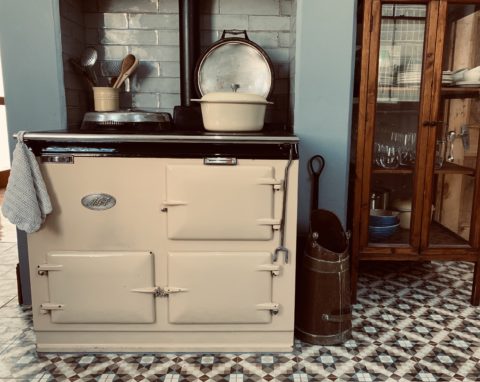
A newly-fitted mini AGA. On the simmering plate sits an original AGA pot, in the same colour scheme as the cooker. (Photo: Louzel Lombard Steyn)
A big green one in my parent’s farm kitchen on the outskirts of Cradock has the nickname “Groen Ans”, while a mini-version newly-fitted in my Port Elizabeth home has been dubbed “Mooi Nooi”. “She’s still a young lass,” Oom Arthur said when he first gazed upon our small, cream, three-door AGA. “She’ll run many more miles with you.”
Here’s hoping the same for you and your cream Datsun, Oom Arthur. DM/TGIFood
Do you have an AGA in need of special care? Contact Arthur Reid & Sons AGA Services on Facebook or telephonically at 063 617 7967.





 Become an Insider
Become an Insider
Utterly delightful, thank you. We had a cantankerous Rayburn range (AGA owners look down their noses at them) in a house in Wales in my youth – and much of my family owned AGAs… the only pity, of course, is that they run on coal. I seem to remember they can run on gas too, not so?
Brings back incredible memories of Riversdale in the Cape. A large kitchen….with a large square table in the middle…& a huge AGA along the wall. It was paradise in winter… Everyone wanted to be in the kitchen. And, of course, the dogs & cats…
I don’t want to be too much of a pedant, but the caption to the photograph showing Arthur Reid and his son Ralton, serves to remind us that AGA’s should never be lied to – they’re quiet sensitive that way.